 IAS on Facebook IAS on Facebook
 IAS on Instagram IAS on Instagram

|

IAS Aroid Quasi Forum
About Aroid-L
This is a continuously updated archive of the Aroid-L mailing list in a forum format - not an actual Forum. If you want to post, you will still need to register for the Aroid-L mailing list and send your postings by e-mail for moderation in the normal way.
|
Supervolute vernation. Finally a photo!
|
From: ExoticRainforest <Steve at ExoticRainforest.com> on 2010.01.13 at 21:02:44(20467)

There are several types of leaf vernation when a new leaf firstemerges. Vernation is simply the way a new leaf blade is rolled orfolded as it begins to emerge from the cataphyll.
Although there are several forms of vernation in aroids the most commontype is known as convolute vernation which describes the edges of anewly unfurling leaf blade which have both margins (edges) curledinward wrapping around each other. This is observed when the new bladeemerges from the cataphyll and the wrapping of one margin is rolledover the other. The mechanism makes the emerging leaf present itself asa tube.
The second is known as involute vernation and is observed when a newlydeveloping leaf emerges from the cataphyll when both margins (edges) onopposing sides of the leaf blade are rolled forming two inward facingtubes that meet at the midrib of the leaf. This type is not as commonas convolute vernation.
The least common is known as supervolute vernation. I have been workingfor weeks to complete an article for the next issue of Aroideana (thejournal of the International Aroid Society) to be published in August.That article attempts to make many of the terms used in scientificliterature easy for a collector to understand and use. One of the mostdifficult definitions to write was the one for supervolute vernationsince a definition did not exist in any of the scientific texts orjournals I own. I couldn't even find a definition on the internet andthe definition I found on the internet for "supervolute" was impossibleto understand. Look it up and see if you can figure out what they aretrying to say!
Finally my friend Leland Miyano sent a photo of a newly emerging leafof Anthurium hookeri and the definition Dr. Tom Croat helpedto clarify suddenly became crystal clear. Until I received this photo Ihad no real idea what supervolute vernation really meant.
supervolute vernation
Possessing a convolute arrangement in the folding or arrangement of anewly emerging leaf blade with one margin (edge) of the newly bladeemerging rolled inward toward the midrib and the opposite margin rolledaround the midrib as well as the remainder of the leaf in a mannersimilar to the coiled whorl at the end of a conch shell.
My thanks to Leland for the photo!
If you believe you are growing Anthurium hookeri you may wantto look at this page! I have been trying to find a specimen for yearsand so far have never been able to buy one since all the plantsavailable for sale are not the species but instead are a hybrid.
If the plant doesn't have scalariforme (ladder-like) vernation,glandular punctates (tiny black spots) on the back of the leaf, andproduces white berries on an inflorescence instead of the read oneseveryone believes the species should produce it isn't the real Anthuriumhookeri.
http://www.exoticrainforest.com/Anthurium%20hookeri%20pc.html
Steve
| HTML +More | |
www.ExoticRainforest.com
--------------020801000305060308000408 |
|
From: "Marek Argent" <abri1973 at wp.pl> on 2010.01.14 at 12:57:24(20469)
Dear Steve,
I tried to undrestand the definition of supervolute vernation, but it exceeds my 3D imagination
and I still don't know if I understand the terms "convolute" and "involute" properly.
Here are links to photos of convolute and involute vernating leaves of Amorphophallus species.
Is this correctly?
http://www.wschowa.com/abrimaal/araceum/amorphophallus/haematospadix.htm#2007
http://www.wschowa.com/abrimaal/araceum/amorphophallus/bulbifer.htm#2007
Marek
| HTML +More | |
----- Original Message -----
From: ExoticRainforest
To: Discussion of aroids
Sent: Wednesday, January 13, 2010 10:02 PM
Subject: [Aroid-l] Supervolute vernation. Finally a photo!
There are several types of leaf vernation when a new leaf first emerges. Vernation is simply the way a new leaf blade is rolled or folded as it begins to emerge from the cataphyll.
Although there are several forms of vernation in aroids the most common type is known as convolute vernation which describes the edges of a newly unfurling leaf blade which have both margins (edges) curled inward wrapping around each other. This is observed when the new blade emerges from the cataphyll and the wrapping of one margin is rolled over the other. The mechanism makes the emerging leaf present itself as a tube.
The second is known as involute vernation and is observed when a newly developing leaf emerges from the cataphyll when both margins (edges) on opposing sides of the leaf blade are rolled forming two inward facing tubes that meet at the midrib of the leaf. This type is not as common as convolute vernation.
The least common is known as supervolute vernation. I have been working for weeks to complete an article for the next issue of Aroideana (the journal of the International Aroid Society) to be published in August. That article attempts to make many of the terms used in scientific literature easy for a collector to understand and use. One of the most difficult definitions to write was the one for supervolute vernation since a definition did not exist in any of the scientific texts or journals I own. I couldn't even find a definition on the internet and the definition I found on the internet for "supervolute" was impossible to understand. Look it up and see if you can figure out what they are trying to say!
Finally my friend Leland Miyano sent a photo of a newly emerging leaf of Anthurium hookeri and the definition Dr. Tom Croat helped to clarify suddenly became crystal clear. Until I received this photo I had no real idea what supervolute vernation really meant.
supervolute vernation
Possessing a convolute arrangement in the folding or arrangement of a newly emerging leaf blade with one margin (edge) of the newly blade emerging rolled inward toward the midrib and the opposite margin rolled around the midrib as well as the remainder of the leaf in a manner similar to the coiled whorl at the end of a conch shell.
My thanks to Leland for the photo!
If you believe you are growing Anthurium hookeri you may want to look at this page! I have been trying to find a specimen for years and so far have never been able to buy one since all the plants available for sale are not the species but instead are a hybrid.
If the plant doesn't have scalariforme (ladder-like) vernation, glandular punctates (tiny black spots) on the back of the leaf, and produces white berries on an inflorescence instead of the read ones everyone believes the species should produce it isn't the real Anthurium hookeri.
http://www.exoticrainforest.com/Anthurium%20hookeri%20pc.html
Steve
www.ExoticRainforest.com
_______________________________________________
Aroid-L mailing list
Aroid-L@www.gizmoworks.com
http://www.gizmoworks.com/mailman/listinfo/aroid-l
Nie znaleziono virusa w tej wiadomosci przychodzacej.
Sprawdzone przez AVG - www.avg.com
Wersja: 8.5.432 / Baza danych wirusów: 270.14.139/2620 - Data wydania: 01/14/10 07:35:00
------=_NextPart_000_00BC_01CA9521.7FDD7640----==============v00124165554606052=� |
|
From: "Marek Argent" <abri1973 at wp.pl> on 2010.01.14 at 14:49:56(20470)
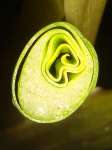

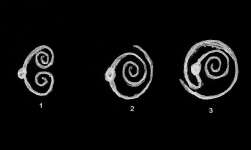
I took a photo of an unflolding leaf of Zantedeschia aethiopica. Is this convolute venation?
The thick part is the midrib.
I also made a simple drawing. I think 1 is involute, 2 is convolute and how to draw supervolute?
Or 2 is supervolute?
Marek
| HTML +More | |
----- Original Message -----
From: ExoticRainforest
To: Discussion of aroids
Sent: Wednesday, January 13, 2010 10:02 PM
Subject: [Aroid-l] Supervolute vernation. Finally a photo!
There are several types of leaf vernation when a new leaf first emerges. Vernation is simply the way a new leaf blade is rolled or folded as it begins to emerge from the cataphyll.
Although there are several forms of vernation in aroids the most common type is known as convolute vernation which describes the edges of a newly unfurling leaf blade which have both margins (edges) curled inward wrapping around each other. This is observed when the new blade emerges from the cataphyll and the wrapping of one margin is rolled over the other. The mechanism makes the emerging leaf present itself as a tube.
The second is known as involute vernation and is observed when a newly developing leaf emerges from the cataphyll when both margins (edges) on opposing sides of the leaf blade are rolled forming two inward facing tubes that meet at the midrib of the leaf. This type is not as common as convolute vernation.
The least common is known as supervolute vernation. I have been working for weeks to complete an article for the next issue of Aroideana (the journal of the International Aroid Society) to be published in August. That article attempts to make many of the terms used in scientific literature easy for a collector to understand and use. One of the most difficult definitions to write was the one for supervolute vernation since a definition did not exist in any of the scientific texts or journals I own. I couldn't even find a definition on the internet and the definition I found on the internet for "supervolute" was impossible to understand. Look it up and see if you can figure out what they are trying to say!
Finally my friend Leland Miyano sent a photo of a newly emerging leaf of Anthurium hookeri and the definition Dr. Tom Croat helped to clarify suddenly became crystal clear. Until I received this photo I had no real idea what supervolute vernation really meant.
supervolute vernation
Possessing a convolute arrangement in the folding or arrangement of a newly emerging leaf blade with one margin (edge) of the newly blade emerging rolled inward toward the midrib and the opposite margin rolled around the midrib as well as the remainder of the leaf in a manner similar to the coiled whorl at the end of a conch shell.
My thanks to Leland for the photo!
If you believe you are growing Anthurium hookeri you may want to look at this page! I have been trying to find a specimen for years and so far have never been able to buy one since all the plants available for sale are not the species but instead are a hybrid.
If the plant doesn't have scalariforme (ladder-like) vernation, glandular punctates (tiny black spots) on the back of the leaf, and produces white berries on an inflorescence instead of the read ones everyone believes the species should produce it isn't the real Anthurium hookeri.
http://www.exoticrainforest.com/Anthurium%20hookeri%20pc.html
Steve
www.ExoticRainforest.com
_______________________________________________
Aroid-L mailing list
Aroid-L@www.gizmoworks.com
http://www.gizmoworks.com/mailman/listinfo/aroid-l
Nie znaleziono virusa w tej wiadomosci przychodzacej.
Sprawdzone przez AVG - www.avg.com
Wersja: 8.5.432 / Baza danych wirusów: 270.14.139/2620 - Data wydania: 01/14/10 07:35:00
------=_NextPart_001_00EF_01CA9531.38238AF0--------=_NextPart_000_00EE_01CA9531.382363E0 |
|
From: Don Bittel <donbit121 at hotmail.com> on 2010.01.15 at 05:04:33(20475)
I have always thought that convolute and supervolute vernation were the same thing. That is, that the left side is wrapped around the right side, which is wrapped around itself. Or vice versa, with right around the left. Most aroids are this way.
The Pachyneurium anthuriums are involute, looking like two tubes side by side. This includes the common birdnest types, as well as some heart shaped leaves, like standleyi and watermaliense. Aren't there just these two types of vernation?
You mention that most of the plants sold as hookeri are hybrids. I think that most are true species of pachyneurium types, and if hybrids are certainly not hybrids of hookeri, but are hybrids of schlectendallii or crispamarginata or other common birdnest types.
And in your last paragraph, you write about scalariform VERnation, which should be scalariform VEnation, referring to the vein structure of the leaf. Just a typo, but confusing to the subject at hand.
shivering in south florida,
Don Bittel
| HTML +More | |
________________________
Wed, 13 Jan 2010 15:02:44 -0600
From: Steve@exoticrainforest.com
To: aroid-l@gizmoworks.com
Subject: [Aroid-l] Supervolute vernation. Finally a photo!
There are several types of leaf vernation when a new leaf firstemerges. Vernation is simply the way a new leaf blade is rolled orfolded as it begins to emerge from the cataphyll.
Although there are several forms of vernation in aroids the most commontype is known as convolute vernation which describes the edges of anewly unfurling leaf blade which have both margins (edges) curledinward wrapping around each other. This is observed when the new bladeemerges from the cataphyll and the wrapping of one margin is rolledover the other. The mechanism makes the emerging leaf present itself asa tube.
The second is known as involute vernation and is observed when a newlydeveloping leaf emerges from the cataphyll when both margins (edges) onopposing sides of the leaf blade are rolled forming two inward facingtubes that meet at the midrib of the leaf. This type is not as commonas convolute vernation.
The least common is known as supervolute vernation. I have been workingfor weeks to complete an article for the next issue of Aroideana (thejournal of the International Aroid Society) to be published in August.That article attempts to make many of the terms used in scientificliterature easy for a collector to understand and use. One of the mostdifficult definitions to write was the one for supervolute vernationsince a definition did not exist in any of the scientific texts orjournals I own. I couldn't even find a definition on the internet andthe definition I found on the internet for "supervolute" was impossibleto understand. Look it up and see if you can figure out what they aretrying to say!
Finally my friend Leland Miyano sent a photo of a newly emerging leafof Anthurium hookeri and the definition Dr. Tom Croat helpedto clarify suddenly became crystal clear. Until I received this photo Ihad no real idea what supervolute vernation really meant.
supervolute vernation
Possessing a convolute arrangement in the folding or arrangement of anewly emerging leaf blade with one margin (edge) of the newly bladeemerging rolled inward toward the midrib and the opposite margin rolledaround the midrib as well as the remainder of the leaf in a mannersimilar to the coiled whorl at the end of a conch shell.
My thanks to Leland for the photo!
If you believe you are growing Anthurium hookeri you may wantto look at this page! I have been trying to find a specimen for yearsand so far have never been able to buy one since all the plantsavailable for sale are not the species but instead are a hybrid.
If the plant doesn't have scalariforme (ladder-like) vernation,glandular punctates (tiny black spots) on the back of the leaf, andproduces white berries on an inflorescence instead of the read oneseveryone believes the species should produce it isn't the real Anthuriumhookeri.
http://www.exoticrainforest.com/Anthurium%20hookeri%20pc.html
Steve
www.ExoticRainforest.com
Hotmail: Trusted email with powerful SPAM protection. Sign up now.--_cf48c1a2-0a2b-4110-b0ab-96f6f1f206e6_----==============F77633782115166705=� |
|
From: Peter Boyce <phymatarum at googlemail.com> on 2010.01.16 at 04:52:00(20479)
The point about convolute is that the next leaf in the module isenclosed within the current leaf. In aroids all except Lagenandra, thepachyneurium Anthurium, and Amorphophallus (all of which are involute) areconvolute, with the individual leaves supervolute. See Stearn, Bot. Latin 343-344,Fig. 29 368 & 369.
Pete
| HTML +More |
From: aroid-l-bounces@gizmoworks.com[mailto:aroid-l-bounces@gizmoworks.com] On Behalf Of Don Bittel
Sent: Friday, 15 January, 2010 1:05 PM
To: Discussion of aroids
Subject: Re: [Aroid-l] Supervolute vernation. Finally a photo!
Ihave always thought that convolute and supervolute vernation were the samething. That is, that the left side is wrapped around the right side, which iswrapped around itself. Or vice versa, with right around the left. Most aroidsare this way.
ThePachyneurium anthuriums are involute, looking like two tubes side by side. Thisincludes the common birdnest types, as well as some heart shaped leaves, likestandleyi and watermaliense. Aren't there just these two types ofvernation?
Youmention that most of the plants sold as hookeri are hybrids. I think that mostare true species of pachyneurium types, and if hybrids are certainly nothybrids of hookeri, but are hybrids of schlectendallii or crispamarginata orother common birdnest types.
Andin your last paragraph, you write about scalariform VERnation, which should bescalariform VEnation, referring to the vein structure of the leaf. Just a typo,but confusing to the subject at hand.
shiveringin south florida,
DonBittel
________________________
Wed,13 Jan 2010 15:02:44 -0600
From: Steve@exoticrainforest.com
To: aroid-l@gizmoworks.com
Subject: [Aroid-l] Supervolute vernation. Finally a photo!
There are several typesof leaf vernation when a new leaf first emerges. Vernation is simply the way anew leaf blade is rolled or folded as it begins to emerge from the cataphyll.
Although there are several forms of vernation in aroids the most common type isknown as convolute vernation which describes the edges of a newly unfurlingleaf blade which have both margins (edges) curled inward wrapping around eachother. This is observed when the new blade emerges from the cataphyll and thewrapping of one margin is rolled over the other. The mechanism makes theemerging leaf present itself as a tube.
The second is known as involute vernation and is observed when a newlydeveloping leaf emerges from the cataphyll when both margins (edges) onopposing sides of the leaf blade are rolled forming two inward facing tubesthat meet at the midrib of the leaf. This type is not as common as convolutevernation.
The least common is known as supervolute vernation. I have been working forweeks to complete an article for the next issue of Aroideana (the journal ofthe International Aroid Society) to be published in August. That articleattempts to make many of the terms used in scientific literature easy for acollector to understand and use. One of the most difficult definitions to writewas the one for supervolute vernation since a definition did not exist in anyof the scientific texts or journals I own. I couldn't even find a definition onthe internet and the definition I found on the internet for"supervolute" was impossible to understand. Look it up and see if youcan figure out what they are trying to say!
Finally my friend Leland Miyano sent a photo of a newly emerging leaf of Anthuriumhookeri and the definition Dr. Tom Croat helped to clarify suddenly becamecrystal clear. Until I received this photo I had no real idea what supervolutevernation really meant.
supervolute vernation
Possessing a convolute arrangement in the folding or arrangement of a newlyemerging leaf blade with one margin (edge) of the newly blade emerging rolledinward toward the midrib and the opposite margin rolled around the midrib aswell as the remainder of the leaf in a manner similar to the coiled whorl atthe end of a conch shell.
My thanks to Leland for the photo!
If you believe you are growing Anthurium hookeri you may want to look atthis page! I have been trying to find a specimen for years and so farhave never been able to buy one since all the plants available for sale are notthe species but instead are a hybrid.
If the plant doesn't have scalariforme (ladder-like) vernation, glandularpunctates (tiny black spots) on the back of the leaf, and produces whiteberries on an inflorescence instead of the read ones everyone believes thespecies should produce it isn't the real Anthurium hookeri.
http://www.exoticrainforest.com/Anthurium%20hookeri%20pc.html
Steve
www.ExoticRainforest.com
Hotmail:Trusted email with powerful SPAM protection. Sign upnow.
------=_NextPart_000_0040_01CA96AA.B6DB42F0----==============a72035350268810148=� |
|
From: "Marek Argent" <abri1973 at wp.pl> on 2010.01.16 at 14:51:28(20481)

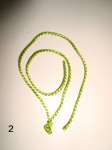
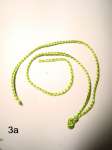
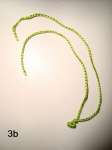

Hello Don,
Look at these photos and imagine that the cord is a leaf in cross section, while the node is the midrib.
No. 1 shows the involute vernation, both halves of the leaf are rolled independently. This is observed in the genus Lagenandra, but not only, what confirms the photo of Amophophallus bulbifer leaflet unfolding involutely which I sent in the prevoius message.
No. 2 is the most common type of vernation in Araceae, it was depicted in the photo of Zantedeschia leaf I sent previously. as I know a little Latin, I would call it supervolute. "Super" means "over" "above". One half of a leaf is wrapped by the other half, the internal half remains rolled until the wrapping half unfolds.
One half is rolled clockwise, the other one is rolled counter-clockwise (looking from the midrib).
No. 3a, 3b, 3c is the problem. "Con" means "together". In this case both halves are in the same roll, paralelly unfolding in the same direction by contrast to the type 2. This is what I would call convolute, I haven't observed this in aroids yet, however it is possible.
Marek
| HTML +More | |
----- Original Message -----
From: Don Bittel
To: Discussion of aroids
Sent: Friday, January 15, 2010 6:04 AM
Subject: Re: [Aroid-l] Supervolute vernation. Finally a photo!
I have always thought that convolute and supervolute vernation were the same thing. That is, that the left side is wrapped around the right side, which is wrapped around itself. Or vice versa, with right around the left. Most aroids are this way.
The Pachyneurium anthuriums are involute, looking like two tubes side by side. This includes the common birdnest types, as well as some heart shaped leaves, like standleyi and watermaliense. Aren't there just these two types of vernation?
You mention that most of the plants sold as hookeri are hybrids. I think that most are true species of pachyneurium types, and if hybrids are certainly not hybrids of hookeri, but are hybrids of schlectendallii or crispamarginata or other common birdnest types.
And in your last paragraph, you write about scalariform VERnation, which should be scalariform VEnation, referring to the vein structure of the leaf. Just a typo, but confusing to the subject at hand.
shivering in south florida,
Don Bittel
________________________
Wed, 13 Jan 2010 15:02:44 -0600
From: Steve@exoticrainforest.com
To: aroid-l@gizmoworks.com
Subject: [Aroid-l] Supervolute vernation. Finally a photo!
There are several types of leaf vernation when a new leaf first emerges. Vernation is simply the way a new leaf blade is rolled or folded as it begins to emerge from the cataphyll.
Although there are several forms of vernation in aroids the most common type is known as convolute vernation which describes the edges of a newly unfurling leaf blade which have both margins (edges) curled inward wrapping around each other. This is observed when the new blade emerges from the cataphyll and the wrapping of one margin is rolled over the other. The mechanism makes the emerging leaf present itself as a tube.
The second is known as involute vernation and is observed when a newly developing leaf emerges from the cataphyll when both margins (edges) on opposing sides of the leaf blade are rolled forming two inward facing tubes that meet at the midrib of the leaf. This type is not as common as convolute vernation.
The least common is known as supervolute vernation. I have been working for weeks to complete an article for the next issue of Aroideana (the journal of the International Aroid Society) to be published in August. That article attempts to make many of the terms used in scientific literature easy for a collector to understand and use. One of the most difficult definitions to write was the one for supervolute vernation since a definition did not exist in any of the scientific texts or journals I own. I couldn't even find a definition on the internet and the definition I found on the internet for "supervolute" was impossible to understand. Look it up and see if you can figure out what they are trying to say!
Finally my friend Leland Miyano sent a photo of a newly emerging leaf of Anthurium hookeri and the definition Dr. Tom Croat helped to clarify suddenly became crystal clear. Until I received this photo I had no real idea what supervolute vernation really meant.
supervolute vernation
Possessing a convolute arrangement in the folding or arrangement of a newly emerging leaf blade with one margin (edge) of the newly blade emerging rolled inward toward the midrib and the opposite margin rolled around the midrib as well as the remainder of the leaf in a manner similar to the coiled whorl at the end of a conch shell.
My thanks to Leland for the photo!
If you believe you are growing Anthurium hookeri you may want to look at this page! I have been trying to find a specimen for years and so far have never been able to buy one since all the plants available for sale are not the species but instead are a hybrid.
If the plant doesn't have scalariforme (ladder-like) vernation, glandular punctates (tiny black spots) on the back of the leaf, and produces white berries on an inflorescence instead of the read ones everyone believes the species should produce it isn't the real Anthurium hookeri.
http://www.exoticrainforest.com/Anthurium%20hookeri%20pc.html
Steve
www.ExoticRainforest.com
Hotmail: Trusted email with powerful SPAM protection. Sign up now.
_______________________________________________
Aroid-L mailing list
Aroid-L@www.gizmoworks.com
http://www.gizmoworks.com/mailman/listinfo/aroid-l
Nie znaleziono virusa w tej wiadomosci przychodzacej.
Sprawdzone przez AVG - www.avg.com
Wersja: 8.5.432 / Baza danych wirusów: 270.14.141/2622 - Data wydania: 01/14/10 19:35:00
------=_NextPart_001_0164_01CA96C3.C42DDE90--------=_NextPart_000_0163_01CA96C3.C42DB780 |
|
From: ExoticRainforest <Steve at ExoticRainforest.com> on 2010.01.17 at 22:24:48(20486)

Thanks Pete. This is slowlybecoming clearer! Tom and I have been bouncing email over this forseveral days.
I did notice something strange about the plant you helped to ID as Philodendronpusillum. I showed the photos to Eduardo and he appears to agree. The plant has grown larger blades since then which I need to show tohim again for confirmation.
A few months ago I noticed it was producing a new blade that appearedto be involute but the one opening now is going to be convolute. Aphoto is attached.
Any ideas?
Steve
| HTML +More | |
www.ExoticRainforest.com
Peter Boyce wrote:
Thepoint about convolute is that the next leaf in the module isenclosed within the current leaf. In aroids all except Lagenandra, thepachyneurium Anthurium, and Amorphophallus (all of which are involute)areconvolute, with the individual leaves supervolute. See Stearn, Bot.Latin 343-344,Fig. 29 368 & 369.
Pete
-l
--------------020706030604090903070700 |
|
From: ExoticRainforest <Steve at exoticrainforest.com> on 2010.01.19 at 01:19:13(20489)
Marek,
I too have been having the same problem. I thought I had this figuredout but there is still some mystery since I've now been toldsupervolute is quite common and the definition is the same asconvolute. Involute appears as two tubes rolled inward. There appearsto be a minor difference between supervolute and convolute but eventhough I thought I had that figured out I'm no longer certain. Iordered a copy of Stern's Botanical Latin which is supposed to make allthis clearer. I would suggest anyone interested order a copy fromAmazon for $20 or less. The difference appears to involve whetherthere is a single flower or group involved but I dare not offer what Iunderstand and would prefer someone with a higher level of educationrespond.
Steve
| HTML +More | |
Marek Argent wrote:
Dear Steve,
I tried to undrestand the definitionof supervolute vernation, but it exceeds my 3D imagination
and I still don't know if Iunderstand the terms "convolute" and "involute" properly.
Here are links to photos ofconvolute and involute vernating leaves of Amorphophallus species.
Is this correctly?
http://www.wschowa.com/abrimaal/araceum/amorphophallus/haematospadix.htm#2007
http://www.wschowa.com/abrimaal/araceum/amorphophallus/bulbifer.htm#2007
Marek
--------------090501020203070701060409 |
|
From: Susan B <honeybunny442 at yahoo.com> on 2010.01.19 at 04:05:46(20490)
Great explanation, Marek, thank you!
Susan
| HTML +More | |
--- On Sat, 1/16/10, Marek Argent wrote:
From: Marek Argent
Subject: Re: [Aroid-l] Supervolute vernation. Finally a photo!
To: "Discussion of aroids"
Date: Saturday, January 16, 2010, 9:51 AM
Hello Don,
Look at these photos and imagine that the cord is a leaf in cross section, while the node is the midrib.
No. 1 shows the involute vernation, both halves of the leaf are rolled independently. This is observed in the genus Lagenandra, but not only, what confirms the photo of Amophophallus bulbifer leaflet unfolding involutely which I sent in the prevoius message.
No. 2 is the most common type of vernation in Araceae, it was depicted in the photo of Zantedeschia leaf I sent previously. as I know a little Latin, I would call it supervolute. "Super" means "over" "above". One half of a leaf is wrapped by the other half, the internal half remains rolled until the wrapping half unfolds.
One half is rolled clockwise, the other one is rolled counter-clockwise (looking from the midrib).
No. 3a, 3b, 3c is the problem. "Con" means "together". In this case both halves are in the same roll, paralelly unfolding in the same direction by contrast to the type 2. This is what I would call convolute, I haven't observed this in aroids yet, however it is possible.
Marek
----- Original Message -----
From: Don Bittel
To: Discussion of aroids
Sent: Friday, January 15, 2010 6:04 AM
Subject: Re: [Aroid-l] Supervolute vernation. Finally a photo!
I have always thought that convolute and supervolute vernation were the same thing. That is, that the left side is wrapped around the right side, which is wrapped around itself. Or vice versa, with right around the left. Most aroids are this way.
The Pachyneurium anthuriums are involute, looking like two tubes side by side. This includes the common birdnest types, as well as some heart shaped leaves, like standleyi and watermaliense. Aren't there just these two types of vernation?
You mention that most of the plants sold as hookeri are hybrids. I think that most are true species of pachyneurium types, and if hybrids are certainly not hybrids of hookeri, but are hybrids of schlectendallii or crispamarginata or other common birdnest types.
And in your last paragraph, you write about scalariform VERnation, which should be scalariform VEnation, referring to the vein structure of the leaf. Just a typo, but confusing to the subject at hand.
shivering in south florida,
Don Bittel
________________________
Wed, 13 Jan 2010 15:02:44 -0600
From: Steve@exoticrainforest.com
To: aroid-l@gizmoworks.com
Subject: [Aroid-l] Supervolute vernation. Finally a photo!
There are several types of leaf vernation when a new leaf first emerges. Vernation is simply the way a new leaf blade is rolled or folded as it begins to emerge from the cataphyll.
Although there are several forms of vernation in aroids the most common type is known as convolute vernation which describes the edges of a newly unfurling leaf blade which have both margins (edges) curled inward wrapping around each other. This is observed when the new blade emerges from the cataphyll and the wrapping of one margin is rolled over the other. The mechanism makes the emerging leaf present itself as a tube.
The second is known as involute vernation and is observed when a newly developing leaf emerges from the cataphyll when both margins (edges) on opposing sides of the leaf blade are rolled forming two inward facing tubes that meet at the midrib of the leaf. This type is not as common as convolute vernation.
The least common is known as supervolute vernation. I have been working for weeks to complete an article for the next issue of Aroideana (the journal of the International Aroid Society) to be published in August. That article attempts to make many of the terms used in scientific literature easy for a collector to understand and use. One of the most difficult definitions to write was the one for supervolute vernation since a definition did not exist in any of the scientific texts or journals I own. I couldn't even find a definition on the internet and the definition I found on the internet for "supervolute" was impossible to understand. Look it up and see if you can figure out what they are trying to say!
Finally my friend Leland Miyano sent a photo of a newly emerging leaf of Anthurium hookeri and the definition Dr. Tom Croat helped to clarify suddenly became crystal clear. Until I received this photo I had no real idea what supervolute vernation really meant.
supervolute vernation
Possessing a convolute arrangement in the folding or arrangement of a newly emerging leaf blade with one margin (edge) of the newly blade emerging rolled inward toward the midrib and the opposite margin rolled around the midrib as well as the remainder of the leaf in a manner similar to the coiled whorl at the end of a conch shell.
My thanks to Leland for the photo!
If you believe you are growing Anthurium hookeri you may want to look at this page! I have been trying to find a specimen for years and so far have never been able to buy one since all the plants available for sale are not the species but instead are a hybrid.
If the plant doesn't have scalariforme (ladder-like) vernation, glandular punctates (tiny black spots) on the back of the leaf, and produces white berries on an inflorescence instead of the read ones everyone believes the species should produce it isn't the real Anthurium hookeri.
http://www.exoticrainforest.com/Anthurium%20hookeri%20pc.html
Steve
www.ExoticRainforest.com
Hotmail: Trusted email with powerful SPAM protection. Sign up now.
_______________________________________________
Aroid-L mailing list
Aroid-L@www.gizmoworks.com
http://www.gizmoworks.com/mailman/listinfo/aroid-l
Nie znaleziono virusa w tej wiadomosci przychodzacej.
Sprawdzone przez AVG - www.avg.com
Wersja: 8.5.432 / Baza danych wirusów: 270.14.141/2622 - Data wydania: 01/14/10 19:35:00
-----Inline Attachment Follows-----
_______________________________________________
Aroid-L mailing list
Aroid-L@www.gizmoworks.com
http://www.gizmoworks.com/mailman/listinfo/aroid-l
--0-2107770074-1263873946=:57720----==============�50657534826824287=� |
|
From: ExoticRainforest <Steve at exoticrainforest.com> on 2010.01.19 at 20:05:37(20492)
These drawings are from William T. Stern's Botanical Latin, 4thedition.
Sorry if I made understanding this more difficult.
Steve
| HTML +More | |
www.ExoticRainforest.com
--------------070008090204050102050008 |
|
From: "Marek Argent" <abri1973 at wp.pl> on 2010.01.20 at 01:44:57(20496)
Steve,
We cannot talk about vernation types not seeing the midrib as it is presented on the second drawing.
It can as well be a half of a leaf rolled involutely.
The third drawing (convolute) is what I thought about (but I was afraid to say) -
that the term "convolute" may refer only to at least two objects
like one leaf inside another one or a spadix wrapped by a spathe.
Anyway in my cord photos, the third type, although probably not occuring in Araceae
is possible, so it must have a name too.
It's becoming complicated...
Marek
| HTML +More | |
----- Original Message -----
From: ExoticRainforest
To: Discussion of aroids
Sent: Tuesday, January 19, 2010 9:05 PM
Subject: [Aroid-l] Supervolute vernation. Finally a photo!]
These drawings are from William T. Stern's Botanical Latin, 4th edition.
Sorry if I made understanding this more difficult.
Steve
www.ExoticRainforest.com
_______________________________________________
Aroid-L mailing list
Aroid-L@www.gizmoworks.com
http://www.gizmoworks.com/mailman/listinfo/aroid-l
Nie znaleziono virusa w tej wiadomosci przychodzacej.
Sprawdzone przez AVG - www.avg.com
Wersja: 8.5.432 / Baza danych wirusów: 270.14.150/2632 - Data wydania: 01/19/10 07:34:00
------=_NextPart_000_0459_01CA997A.8D85DAA0----==============‘65791447413306846=� |
|
From: ExoticRainforest <Steve at ExoticRainforest.com> on 2010.01.20 at 02:10:50(20498)
Sorry!!!!!!!!!! I meant leaf, notflower!!
Steve
| HTML +More |
ExoticRainforest wrote:
Marek,
I too have been having the same problem. I thought I had this figuredout but there is still some mystery since I've now been toldsupervolute is quite common and the definition is the same asconvolute. Involute appears as two tubes rolled inward. There appearsto be a minor difference between supervolute and convolute but eventhough I thought I had that figured out I'm no longer certain. Iordered a copy of Stern's Botanical Latin which is supposed to make allthis clearer. I would suggest anyone interested order a copy fromAmazon for $20 or less. The difference appears to involve whetherthere is a single flower or group involved but I dare not offer what Iunderstand and would prefer someone with a higher level of educationrespond.
Steve
--------------060104000309040903080004 |
|
From: ExoticRainforest <Steve at ExoticRainforest.com> on 2010.01.20 at 15:19:55(20501)
Which is one reason I made nofurther attempt at a further explanation. You can find more than adozen types of vernation on pages 332 and 333 with drawings andexplanations. Stern's Botanical Latin can be purchased from Amazon for$20, used copies for less. It is filled with information.
Steve
| HTML +More | |
www.ExoticRainforest.com
Marek Argent wrote:
Steve,
We cannot talk about vernation typesnot seeing the midrib as it is presented on the second drawing.
It can as well be a half of a leafrolled involutely.
The third drawing (convolute) iswhat I thought about (but I was afraid to say) -
that the term "convolute" may referonly to at least two objects
like one leaf inside another one ora spadix wrapped by a spathe.
Anyway in my cord photos, the thirdtype, although probably not occuring in Araceae
is possible, so it must have a nametoo.
It's becoming complicated...
Marek
--------------010806040702090305080602 |
|
From: ExoticRainforest <Steve at exoticrainforest.com> on 2010.01.20 at 16:17:17(20502)

I screwed up big time andinserted the wrong drawing.
These are the correct drawings from Stern's showing the placement ofthe midrib. It appears the only difference in supervolute andconvolute is a leaf forming around another leaf but frankly I stilldon't have a completely satisfactory explanation. I try almost daily on my website to make subjects like this clearer foranyone interested in aroids that does not have or is not interested inearning a degree in botany. I am now to the point of completelyremoving the subject since I am no longer sure I fully understand it orcan help anyone else to understand.
I don't believe any definition in print in any of the 5 botanicaldictionaries I now own make the distinction (if any) between convoluteand supervolute clear. At least in the dictionaries they appear to besynonymous and are one and the same.
Steve
| HTML +More | |
www.ExoticRainforest.com
Marek Argent wrote:
Steve,
We cannot talk about vernation typesnot seeing the midrib as it is presented on the second drawing.
It can as well be a half of a leafrolled involutely.
The third drawing (convolute) iswhat I thought about (but I was afraid to say) -
that the term "convolute" may referonly to at least two objects
like one leaf inside another one ora spadix wrapped by a spathe.
Anyway in my cord photos, the thirdtype, although probably not occuring in Araceae
is possible, so it must have a nametoo.
It's becoming complicated...
Marek
-
These drawings are from William T. Stern's Botanical Latin,4th edition.
--------------020702060404080602050805 |
|
From: "Marek Argent" <abri1973 at wp.pl> on 2010.01.22 at 00:25:34(20507)
 (File Type Not Recognized: attachments/100123175102-2.pdf)
(File Type Not Recognized: attachments/100123175102-2.pdf)
Dear Steve,
So, I suppose that the term "supervolute" refers to the vernation of a solitary leaf
and "convolute" is the same but in reference to a sequence of leaves
or a spadix within a spathe.
I modified a little the drawing sent by you by placing the next leaf and we have the same.
In my library I found a document on Monstera obliqua and there is a photo
of convolute vernation of leaves (page 5).
Marek
| HTML +More | |
----- Original Message -----
From: ExoticRainforest
To: Discussion of aroids ; Marek Argent
Sent: Wednesday, January 20, 2010 5:17 PM
Subject: [Aroid-l] Supervolute vernation. Finally a photo!
I screwed up big time and inserted the wrong drawing.
These are the correct drawings from Stern's showing the placement of the midrib. It appears the only difference in supervolute and convolute is a leaf forming around another leaf but frankly I still don't have a completely satisfactory explanation. I try almost daily on my website to make subjects like this clearer for anyone interested in aroids that does not have or is not interested in earning a degree in botany. I am now to the point of completely removing the subject since I am no longer sure I fully understand it or can help anyone else to understand.
I don't believe any definition in print in any of the 5 botanical dictionaries I now own make the distinction (if any) between convolute and supervolute clear. At least in the dictionaries they appear to be synonymous and are one and the same.
Steve
www.ExoticRainforest.com
Marek Argent wrote:
Steve,
We cannot talk about vernation types not seeing the midrib as it is presented on the second drawing.
It can as well be a half of a leaf rolled involutely.
The third drawing (convolute) is what I thought about (but I was afraid to say) -
that the term "convolute" may refer only to at least two objects
like one leaf inside another one or a spadix wrapped by a spathe.
Anyway in my cord photos, the third type, although probably not occuring in Araceae
is possible, so it must have a name too.
It's becoming complicated...
Marek
-
These drawings are from William T. Stern's Botanical Latin, 4th edition.
_______________________________________________
Aroid-L mailing list
Aroid-L@www.gizmoworks.com
http://www.gizmoworks.com/mailman/listinfo/aroid-l
Nie znaleziono virusa w tej wiadomosci przychodzacej.
Sprawdzone przez AVG - www.avg.com
Wersja: 8.5.432 / Baza danych wirusów: 270.14.151/2633 - Data wydania: 01/19/10 17:49:00
------=_NextPart_001_0129_01CA9B01.CB3FA960--------=_NextPart_000_0128_01CA9B01.CB3F8250 |
|
From: "Tom Croat" <Thomas.Croat at mobot.org> on 2010.01.24 at 23:54:49(20512)
Dear Marek & Steve:
I am looking at these images andwondering if there is any difference at all in those terms (which has alwaysbeen my understanding, ie. That they are two terms that meant the same thing. Ibelieve if you inverted the images they would be the same. All leaves aredeveloped from the apical meristem and so far as I know there is a continuous seriesof leaves being produced and the younger ones are always coming out inside the otherleaves. Can someone better explain how these two differ?
Tom
| HTML +More |
From: aroid-l-bounces@gizmoworks.com[mailto:aroid-l-bounces@gizmoworks.com] OnBehalf Of Marek Argent
Sent: Thursday, January 21, 20106:26 PM
To: Discussion of aroids; SteveLucas
Subject: Re: [Aroid-l] Supervolutevernation. Finally a photo!
Dear Steve,
So, I suppose that the term"supervolute" refers to the vernation of a solitary leaf
and "convolute" is thesame but in reference to a sequence of leaves
or a spadix within a spathe.
I modified a little the drawingsent by you by placing the next leaf and we have the same.
In my library I found a document on Monstera obliqua and there is a photo
of convolute vernation of leaves(page 5).
Marek
----- Original Message -----
From: ExoticRainforest
To: Discussionof aroids ; MarekArgent
Sent: Wednesday,January 20, 2010 5:17 PM
Subject: [Aroid-l]Supervolute vernation. Finally a photo!
I screwed up bigtime and inserted the wrong drawing.
These are the correct drawings from Stern's showing the placement of themidrib. It appears the only difference in supervolute and convolute is aleaf forming around another leaf but frankly I still don't have a completelysatisfactory explanation. I try almost daily on my website to makesubjects like this clearer for anyone interested in aroids that does not haveor is not interested in earning a degree in botany. I am now to thepoint of completely removing the subject since I am no longer sure I fullyunderstand it or can help anyone else to understand.
I don't believe any definition in print in any of the 5 botanical dictionaries Inow own make the distinction (if any) between convolute and supervoluteclear. At least in the dictionaries they appear to be synonymous and areone and the same.
Steve
www.ExoticRainforest.com
Marek Argent wrote:
Steve,
We cannot talk about vernation types not seeing themidrib as it is presented on the second drawing.
It can as well be a half of a leaf rolledinvolutely.
The third drawing (convolute) is what I thought about(but I was afraid to say) -
that the term "convolute" may refer only toat least two objects
like one leaf inside another one or a spadixwrapped by a spathe.
Anyway in my cord photos, the third type, althoughprobably not occuring in Araceae
is possible, so it must have a name too.
It's becoming complicated...
Marek
-
These drawings arefrom William T. Stern's Botanical Latin, 4th edition.
_______________________________________________
Aroid-L mailing list
Aroid-L@www.gizmoworks.com
http://www.gizmoworks.com/mailman/listinfo/aroid-l
Nie znaleziono virusa w tej wiadomosci przychodzacej.
Sprawdzone przez AVG - www.avg.com
Wersja: 8.5.432 / Baza danych wirusów: 270.14.151/2633 - Data wydania: 01/19/1017:49:00
------_=_NextPart_001_01CA9D50.9D11484A----==============�49837570181286554=� |
| |
Note: this is a very old post, so no reply function is available.
|
|














